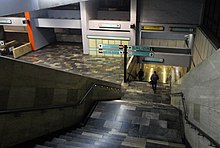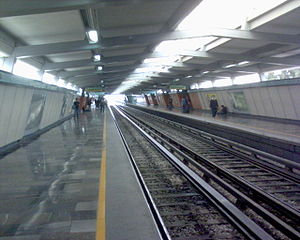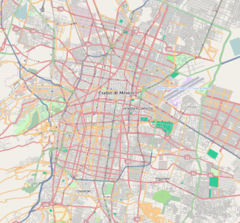Consulado metro station

Consulado metro station[b] is a transfer station of the Mexico City Metro in Gustavo A. Madero and Venustiano Carranza, Mexico City. It is a combined elevated and at-grade station, along Lines 4 (the Aqua Line) and 5 (the Yellow Line). Consulado is located between Bondojito and Canal del Norte stations on Line 4, and between Valle Gómez and Eduardo Molina stations on Line 5. It serves the colonias of 7 de Noviembre, 20 de Noviembre, Felipe Ángeles, and Mártires de Río Blanco.
The station is named after the Consulado River, which runs below Río Consulado Avenue, and its pictogram depicts a water duct, representing the ducted part of the river. Consulado station opened on 29 August 1981 with service northward toward Martín Carrera station and southward toward Candelaria station on Line 4. Southeast service on Line 5 toward Pantitlán metro station started on 19 December 1981. In 2019, the station had an overall average daily ridership of 9,337 passengers, making it one of the least-used stations in the network.
Location
[edit]
Consulado is a metro transfer station in the limits of Gustavo A. Madero and Venustiano Carranza boroughs, in northeastern Mexico City. The station lies on Río Consulado Avenue and Congreso de la Unión Avenue, and serves colonias (Mexican Spanish for "neighborhoods") of 7 de Noviembre and Mártires de Río Blanco, in Gustavo A. Madero, and of 20 de Noviembre and Felipe Ángeles, in Venustiano Carranza. Within the system, it lies between Bondojito and Canal del Norte metro stations on Line 4; on Line 5, between Valle Gómez and Eduardo Molina metro stations.[2] The area is serviced by Line 5 of the Metrobús system at Río Consulado bus station, a few blocks away;[3] by Routes 5-A, 20-A, and 20-B of the city's public bus system[4] and by Routes 37 and 200 of the Red de Transporte de Pasajeros network.[5]
Exits
[edit]There are four exits:[2]
- East: Congreso de la Unión Avenue and Oriente 87 Street, 20 de Noviembre (Line 4).
- West: Congreso de la Unión Avenue and Oriente 85 Street, Mártires de Río Blanco (Line 4).
- North: Río Consulado Avenue and Norte 64-A Street, 7 de Noviembre (Line 5).
- South: Río Consulado Avenue and Cuarzo Street, Felipe Ángeles (Line 5).
History and construction
[edit]
Line 4 of the Mexico City Metro was built by Cometro, a subsidiary of Empresas ICA;[6] Consulado Line 4 opened on 29 August 1981, on the first day of the then Martín Carrera–Candelaria service. It is an elevated station;[7] the interstation stretch between Consulado and Bondojito is 892 meters (2,927 ft) long; the Consulado–Canal del Norte section is 884 m (2,900 ft) long.[8]
Line 5 was built by Empresas ICA;[9] Consulado Line 5 opened on 19 December 1981, on the first day of the service toward Pantitlán station.[10] Northwestern service toward La Raza station started on 1 July 1982.[11] The station was built at-grade level;[7] the Consulado–Valle Gómez interstation is 679 m (2,228 ft) long, while the Consulado–Eduardo Molina section measures 815 m (2,674 ft).[8]
The passenger transfer tunnel that connects both lines is around 400 m (1,300 ft) long.[12] The station's pictogram depicts a water duct, representing the ducted part of the Consulado River, which runs under the station.[2] Inside the Line 5 station, there are four cultural showcases.[2]
Incidents
[edit]According to the system authorities, the Consulado–Valle Gómez section is a common zone of copper wire thefts, which potentially can create fires in the tracks.[13] On 31 July 2018, three railroad cars uncoupled while a train was traveling at the Consulado–Eduardo Molina interstation, with no injuries reported. When the incident was reviewed, authorities found that the nuts that kept the cars together were damaged.[14] After the collapse of the elevated railway near Olivos station on Line 12 in May 2021, users reported the structural damage to other elevated stations, including Consulado station.[15] Mayor of Mexico City, Claudia Sheinbaum, said that the reports would be examined accordingly.[16]
Ridership
[edit]According to the data provided by the authorities since the 2000s, Consulado metro station has been one of the least busy stations of the system's 195 stations. Before the impact of the COVID-19 pandemic on public transport, between 2013 and 2019, commuters averaged per year between 4,300 and 4,600 daily entrances on Line 4 and between 4,800 and 5,200 daily entrances on Line 5. In 2019, the station's ridership totaled 3,408,299 passengers. For Line 4, the ridership was 1,608,777 passengers (4,407 per day), which was a decrease of 15,947 passengers compared to 2018. For Line 5, the station had a ridership of 1,799,522 passengers (4,930 per day), which was a decrease of 6,517 passengers compared to 2018.[17][18]
In 2019, the Line 4 station was the 190th busiest of the system and the line's second least used. The Line 5 station was the 187th busiest in the system and the line's third least used.[17]
| Annual passenger ridership (Line 4) | |||||
|---|---|---|---|---|---|
| Year | Ridership | Average daily | Rank | % change | Ref. |
| 2023 | 1,131,202 | 3,099 | 175/195 | +7.21% | [19] |
| 2022 | 1,055,140 | 2,890 | 172/195 | +39.33% | [19] |
| 2021 | 757,318 | 2,074 | 185/195 | −14.44% | [20] |
| 2020 | 885,105 | 2,418 | 188/195 | −44.98% | [21] |
| 2019 | 1,608,777 | 4,407 | 190/195 | −0.98% | [17] |
| 2018 | 1,624,724 | 4,451 | 190/195 | +2.20% | [18] |
| 2017 | 1,589,728 | 4,355 | 190/195 | +0.22% | [22] |
| 2016 | 1,586,182 | 4,333 | 189/195 | −2.38% | [23] |
| 2015 | 1,624,899 | 4,451 | 181/195 | −0.52% | [24] |
| 2014 | 1,633,327 | 4,474 | 180/195 | −1.71% | [25] |
| Annual passenger ridership (Line 5) | |||||
|---|---|---|---|---|---|
| Year | Ridership | Average daily | Rank | % change | Ref. |
| 2023 | 1,686,931 | 4,621 | 166/195 | +9.76% | [1] |
| 2022 | 1,536,917 | 4,210 | 166/195 | +26.61% | [19] |
| 2021 | 1,213,863 | 3,325 | 165/195 | −5.27% | [20] |
| 2020 | 1,281,437 | 3,501 | 178/195 | −28.79% | [21] |
| 2019 | 1,799,522 | 4,930 | 187/195 | −0.36% | [17] |
| 2018 | 1,806,039 | 4,948 | 188/195 | +1.67% | [18] |
| 2017 | 1,776,427 | 4,866 | 187/195 | −1.51% | [22] |
| 2016 | 1,803,613 | 4,927 | 187/195 | −3.67% | [23] |
| 2015 | 1,872,353 | 5,129 | 178/195 | +2.49% | [24] |
| 2014 | 1,826,820 | 5,004 | 177/195 | −3.31% | [25] |
Notes
[edit]- ^ The Mexico City Metro system counts the entries from interchange stations separately. When counted individually, 1,131,202 passengers accessed through Line 4, while 1,686,931 passengers did it through Line 5.[1]
- ^ Estación del Metro Consulado. Spanish pronunciation: [kon.suˈla.ðo] . The name of the station literally means "Consulate" in Spanish.
References
[edit]- ^ a b c d "Afluencia de estación por línea 2023" [Station traffic per line 2023] (in Spanish). Sistema Transporte Colectivo Metro. 2024. Archived from the original on 27 January 2024. Retrieved 24 January 2024.
- ^ a b c d "Consulado" (in Spanish). Sistema Transporte Colectivo Metro. Archived from the original on 23 February 2021. Retrieved 13 July 2021.
- ^ "L5: mapas de barrio" [L5: neighborhood maps] (in Spanish). Mexico City Metrobús. Archived from the original on 8 April 2019. Retrieved 12 July 2021.
- ^ "Red de corredores" [Route network] (in Spanish). Retrieved 30 October 2021.
- ^ "Red de Rutas" [Routes network] (in Spanish). Red de Transporte de Pasajeros. Retrieved 30 October 2021.
- ^ "Línea 4, Ciudad de México" [Line 4, Mexico City] (in Spanish). iNGENET Infraestructura. 20 July 2009. Archived from the original on 18 January 2021. Retrieved 13 July 2021.
- ^ a b "Metro CDMX: ¿Cuáles son las líneas que circulan por arriba como la Línea 12, es peligroso usarlas?" [Metro CDMX: Like Line 12, which lines are elevated; is it dangerous to ride them?]. El Heraldo de México (in Spanish). 4 May 2021. Archived from the original on 13 July 2021. Retrieved 13 July 2021.
- ^ a b "Longitud de estación a estación por línea" [Station-to-station length per line] (in Spanish). Sistema de Transporte Colectivo Metro. Archived from the original on 4 May 2021. Retrieved 12 July 2021.
- ^ "Línea 5, Ciudad de México" [Line 5, Mexico City] (in Spanish). iNGENET Infraestructura. 20 July 2009. Archived from the original on 2 September 2014. Retrieved 15 April 2020.
- ^ "Baia, Baia, Tacubaya... Las estaciones del metro MÁS y MENOS utilizadas en CDMX" [Well, well, well... The MOST and LEAST used stations in Mexico City] (in Spanish). Nación 321. 4 September 2019. Archived from the original on 15 April 2020. Retrieved 14 April 2020.
- ^ Transporte: Seis años de esfuerzo conjunto (in Spanish). Vol. I. Government of the Federal District Department. 1987. p. 17.
- ^ "Transbordos en el Metro ¿una opción para ejercitarte?" [Metro transfer, a workout option?]. Milenio (in Spanish). 12 January 2018. Archived from the original on 17 January 2019. Retrieved 28 May 2020.
- ^ Wachauf, Daniela (13 July 2021). "Ya les gustó robar cable en la Línea 5 del Metro" [Thefts have liked stealing cable on Metro Line 5]. 24 Horas (in Spanish). Archived from the original on 13 July 2021. Retrieved 2 August 2021.
- ^ Hernández, Eduardo (31 July 2018). "Vagones se desprenden de un convoy en la Línea 5 del Metro" [Train's railcards uncoupled at Metro Line 5]. El Universal (in Spanish). Archived from the original on 14 December 2018.
- ^ "Oceanía se vuelve tendencia por ser 'bomba de tiempo' para otro derrumbe en el Metro: FOTOS" [Oceanía is trending again for being a 'time bomb' for another Metro collapse: PHOTOS]. El Heraldo de México (in Spanish). 4 May 2021. Archived from the original on 6 May 2021. Retrieved 29 May 2021.
- ^ Hernández, Eduardo (4 May 2021). "Se revisarán denuncias por cuarteaduras en Metro Oceanía y Pantitlán: Sheinbaum" [Complaints about cracks in Oceania and Pantitlan stations will be reviewed: Sheinbaum]. El Universal (in Spanish). Archived from the original on 5 May 2021. Retrieved 29 May 2021.
- ^ a b c d "Afluencia de estación por línea 2019" [Station traffic per line 2019] (in Spanish). Sistema Transporte Colectivo Metro. 2020. Archived from the original on 3 July 2020. Retrieved 3 May 2020.
- ^ a b c "Afluencia de estación por línea 2018" [Station traffic per line 2018] (in Spanish). Sistema Transporte Colectivo Metro. 2019. Archived from the original on 6 June 2019. Retrieved 7 April 2020.
- ^ a b c "Afluencia de estación por línea 2022" [Station traffic per line 2022] (in Spanish). Sistema Transporte Colectivo Metro. 2023. Archived from the original on 5 March 2023. Retrieved 5 March 2023.
- ^ a b "Afluencia de estación por línea 2021" [Station traffic per line 2021] (in Spanish). Sistema Transporte Colectivo Metro. 2022. Archived from the original on 7 March 2022. Retrieved 7 March 2022.
- ^ a b "Afluencia de estación por línea 2020" [Station traffic per line 2020] (in Spanish). Sistema Transporte Colectivo Metro. 2021. Archived from the original on 21 June 2021. Retrieved 21 June 2021.
- ^ a b "Afluencia de estación por línea 2017" [Station traffic per line 2017] (in Spanish). Sistema Transporte Colectivo Metro. 2019. Archived from the original on 3 May 2020. Retrieved 3 May 2020.
- ^ a b "Afluencia de estación por línea 2016" [Station traffic per line 2016] (in Spanish). Sistema Transporte Colectivo Metro. 2017. Archived from the original on 3 May 2020. Retrieved 3 May 2020.
- ^ a b "Afluencia de estación por línea 2015" [Station traffic per line 2015] (in Spanish). Sistema Transporte Colectivo Metro. 2016. Archived from the original on 3 May 2020. Retrieved 6 May 2020.
- ^ a b "Afluencia de estación por línea 2014" [Station traffic per line 2014] (in Spanish). Sistema Transporte Colectivo Metro. 2015. Archived from the original on 3 May 2020. Retrieved 6 May 2020.
External links
[edit] Media related to Consulado (station) at Wikimedia Commons
Media related to Consulado (station) at Wikimedia Commons- "Metro Consulado". At the Official Guide to Mexico City.


